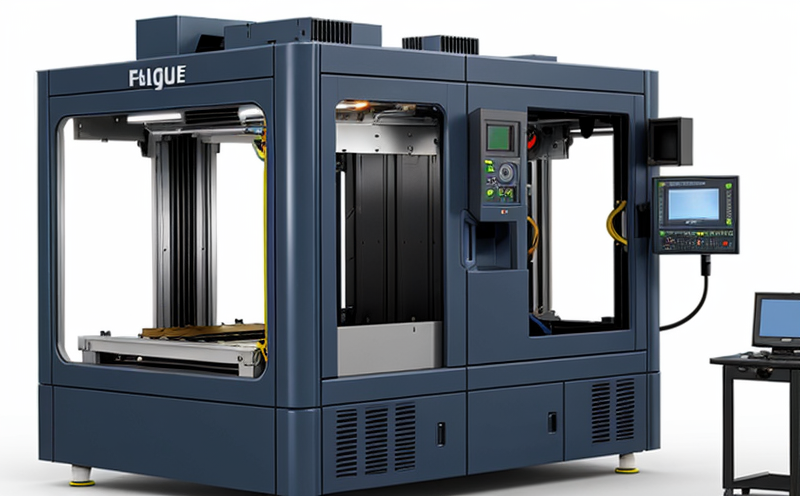ASTM E2368 Fatigue Crack Growth by Variable Amplitude Loading
The ASTM E2368 standard provides a method to determine the fatigue crack growth behavior of materials under variable amplitude loading conditions. This is particularly crucial for Additive Manufacturing (AM) components, which may undergo diverse and unpredictable mechanical stress cycles during their operational life. The testing process focuses on the evolution of cracks in components subjected to cyclic loads that vary in magnitude and direction.
Variable amplitude loading simulates real-world conditions where materials experience fluctuating stresses due to environmental factors or design requirements. This variability can significantly influence the durability and reliability of AM parts, which are increasingly used in critical applications such as aerospace, automotive, and medical devices. By understanding how these components behave under variable loading, manufacturers can optimize designs for longevity and safety.
The ASTM E2368 method is especially important for ensuring that 3D-printed materials meet the necessary durability requirements. The testing process involves subjecting specimens to a series of stress cycles with varying magnitudes and durations. Crack growth is monitored using non-destructive techniques like ultrasonic testing or visual inspection, depending on the material properties.
This type of testing is vital for ensuring that AM components can withstand the rigors of their intended applications without failure. It helps in identifying potential weak points early in the development process, allowing for necessary adjustments to be made before large-scale production begins. The test results provide critical insights into the fatigue life expectancy and reliability of these parts.
For quality managers, compliance officers, R&D engineers, and procurement specialists, understanding ASTM E2368 is essential when evaluating the performance characteristics of AM components. This standard ensures that materials used in additive manufacturing processes adhere to international quality standards, thereby enhancing trustworthiness across industries.
Applied Standards
The primary standard applied here is ASTM E2368, which specifies the procedure for determining fatigue crack growth by variable amplitude loading. This method is particularly relevant in sectors like aerospace, automotive, and medical device manufacturing where reliability under fluctuating loads is paramount.
Other associated standards that complement ASTM E2368 include:
- ISO 17904-1: Guidelines for the testing of fatigue crack growth in metals subjected to variable amplitude loading.
- ASTM E1826: Practice for Fatigue Crack Growth Testing by Variable Amplitude Loading.
- EN 13679: Non-destructive testing - Ultrasonic testing of metallic materials and components using pulse-echo method.
These standards provide a comprehensive framework ensuring that the testing process is consistent with industry best practices, thus enhancing confidence in test results.
EuroLab Advantages
At EuroLab, our commitment to excellence in Additive Manufacturing and 3D Printing Testing sets us apart as a leading provider of ASTM E2368 fatigue crack growth testing services. Our state-of-the-art facilities are equipped with advanced instruments capable of accurately simulating real-world loading conditions, ensuring precise measurement of crack propagation.
Our experienced team of engineers and technicians is dedicated to providing clients with reliable test results that comply strictly with international standards. We offer a range of services tailored specifically for the additive manufacturing industry, including:
- Fatigue testing on AM components under variable amplitude loading conditions.
- Crack growth analysis using advanced non-destructive evaluation techniques.
- Detailed reporting and interpretation of test results to guide design improvements.
We pride ourselves on offering not just compliance services but also valuable insights that can help drive innovation within your organization. Our expertise ensures that every aspect of the testing process is conducted rigorously, delivering accurate data essential for making informed decisions about material selection and component design.
Quality and Reliability Assurance
The quality and reliability assurance in ASTM E2368 fatigue crack growth by variable amplitude loading are critical to ensuring that 3D-printed components meet the stringent requirements of various industries. This involves several key steps:
- Specimen Preparation: Ensuring specimens are accurately manufactured according to specified parameters, including geometry and material composition.
- Loading Conditions: Simulating real-world stress cycles through controlled variable amplitude loading protocols.
- Data Collection: Utilizing advanced non-destructive evaluation methods like ultrasonic testing or visual inspection to monitor crack growth accurately.
- Analysis and Reporting: Providing detailed reports that interpret test results, offering recommendations for improving component design.
By adhering strictly to these processes, EuroLab ensures high-quality results that are reliable indicators of the fatigue behavior of AM components. These tests play a crucial role in validating the durability and safety of 3D-printed parts across different sectors.





